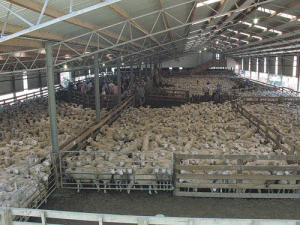MPI defends cost of new biosecurity lab
The head of the Ministry for Primary Industries (MPI) biosecurity operation, Stuart Anderson, has defended the cost and the need for a Plant Healht and Environment Laboratory (PHEL) being built in Auckland.
 NAWAC is satisfied with both the sheep and beef industries’ approaches to breeding with respect to animal welfare issues.
NAWAC is satisfied with both the sheep and beef industries’ approaches to breeding with respect to animal welfare issues.
The National Animal Welfare Advisory Committee (NAWAC) is satisfied with both the sheep and beef industries’ approaches to breeding with respect to animal welfare issues.
NAWAC’s role is to provide independent advice on animal welfare to the Minister for Primary Industries.
One subject of concern for the committee was the effects of selective breeding on the welfare of animals. NAWAC chair Dr Gwyneth Verkerk says they have worked with different sectors to understand their genetic selection parameters and how technology is being used.
In the paper just released, NAWAC gives an independent view on whether selective breeding practices used in New Zealand cause animal welfare concerns.
The report says Beef + Lamb NZ (BLNZ) sees an ethical approach to breeding as producing productive but resilient animals that handle the natural variation in feed supply and climate while producing high quality products in NZ’s range of farm environments.
“Improved longevity, calf survival and cow body condition score are the key to such resilience. In addition, control of inbreeding, which in the past led to the build-up of deleterious recessive genes and inherited diseases, emphasises the need to maintain genetic diversity,” the report says.
“Selective breeding has improved animal health in the beef cattle industry, notably selection for resistance to the facial eczema toxin and internal parasites. Selection for polled breeds obviates the need for disbudding/dehorning. Many of the negative effects of selective breeding have come from taking a narrow view of performance based on very few traits.”
BLNZ Genetics (a subsidiary of BLNZ) is doing research to develop suitable indices for a range of farming environments, the report says. These indices take a wide view of animal performance including growth, reproduction, health and disease traits. A beef progeny test similar to the central progeny test for rams is under development. Issues noted by the NZVA included:
• Elimination of several congenital diseases in Angus cattle
• Previously, heavy selection for meat production, such as the double muscling gene in Belgian Blue cattle, has produced negative outcomes such as dystocia (birthing difficulty) requiring surgical delivery of some calves.
Overall NAWAC is satisfied that the beef industry’s approach to selective breeding, focused as it is on the resilience of these animals in a variety of environments, is appropriate.
Broadly similar concerns occupy NAWAC in respect of the sheep industry.
“An ethical approach to breeding focuses on producing productive but resilient animals that handle the natural variation in feed supply and climate while producing high quality products in NZ’s range of farm environments,” the NAWAC report says.
“Improved longevity, lamb survival and ewe body condition score are the key to such resilience. In addition, control of inbreeding, which in the past led to the build-up of deleterious recessive genes and inherited diseases, emphasises the need to maintain genetic diversity.
“Selective breeding has brought significant improvements in animal health in the sheep industry, with selection for resistance to the facial eczema toxin and internal parasites. Identification of and selection away from deleterious individual genes has also been possible.”
An example is the condition Microphthalmia found primarily within the Texel breed and crosses made out of that breed, which results in blindness due to extremely small eyes – or no eyes, the report says.
Whereas in the past increased fecundity led to lower lamb survival, farmers can now select for improved lamb survival, setting a maximum reproductive rate they believe to be sustainable for their farming system.
“There has been considerable selection for increased growth rates and carcase leanness in sheep. On the other side of that, there is anecdotal evidence that the selection for leanness in slaughter animals has produced breeding ewes that have lower fat reserves, which can impact negatively during times when feed supply is restricted.
“Work is underway investigating increasing fatness in lamb carcases to improve eating quality.
“BLNZ Genetics sees that many of the negative effects of selective breeding have come from taking a narrow view of performance based on very few traits, and is doing research on animal welfare issues associated with selective breeding to develop suitable indexes for a range of farming environments. These indexes take a wide view of animal performance including growth, reproduction, health and disease traits.”
NAWAC says it is satisfied the sheep industry’s approach to selective breeding, focused as it is on the resilience of these animals in a variety of environments, is appropriate.
According to the latest Federated Farmers banking survey, farmers are more satisfied with their bank and less under pressure, however, the sector is well short of confidence levels seen last decade.
Farmer confidence has taken a slight dip according to the final Rabobank rural confidence survey for the year.
Former Agriculture Minister and Otaki farmer Nathan Guy has been appointed New Zealand’s Special Agricultural Trade Envoy (SATE).
Alliance Group has commissioned a new heat pump system at its Mataura processing plant in Southland.
Fonterra has slashed another 50c off its milk price forecast as global milk flows shows no sign of easing.
Meat processors are hopeful that the additional 15% tariff on lamb exports to the US will also come off.

OPINION: The release of the Natural Environment Bill and Planning Bill to replace the Resource Management Act is a red-letter day…
OPINION: Federated Farmers has launched a new campaign, swapping ‘The Twelve Days of Christmas’ for ‘The Twelve Pests of Christmas’ to…